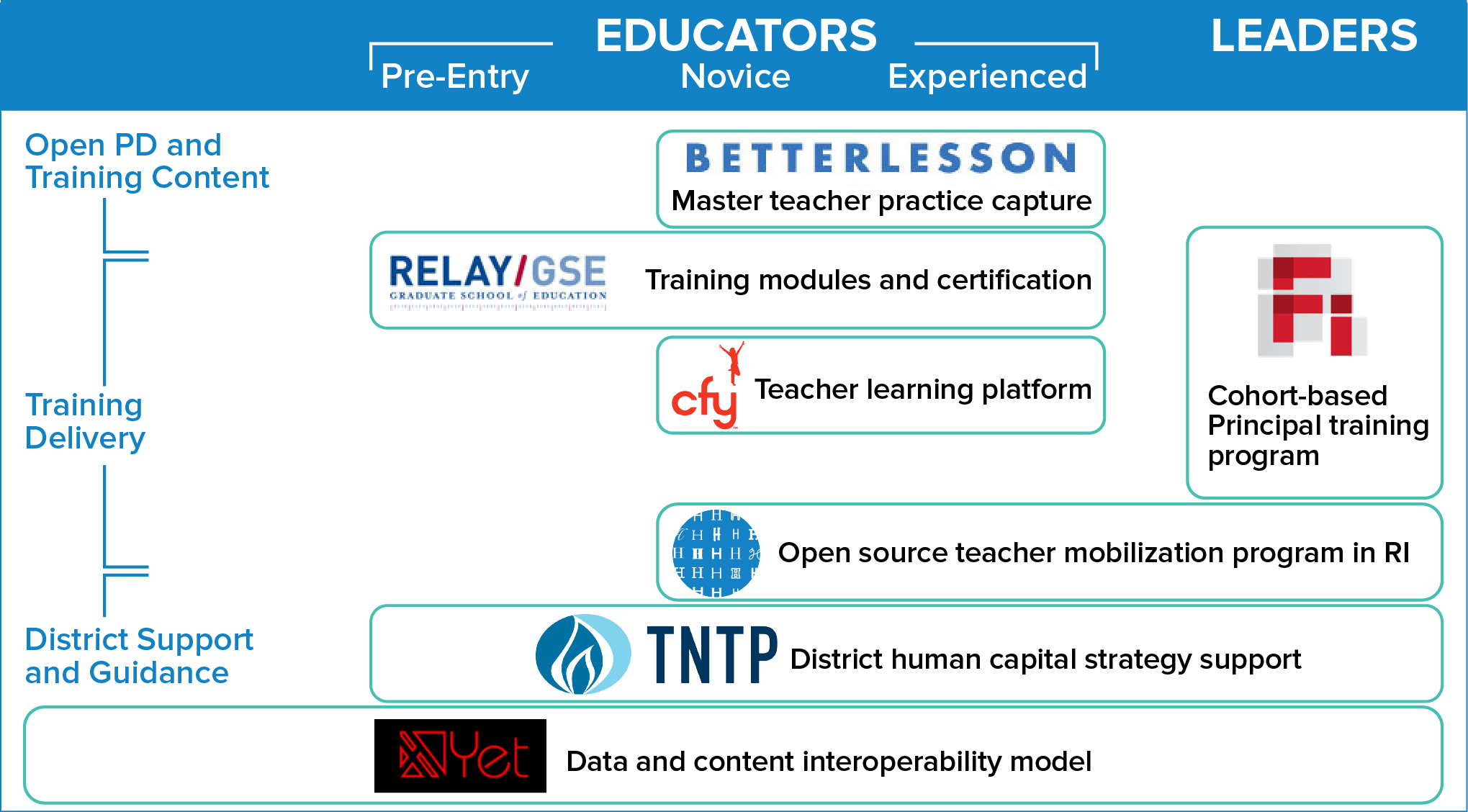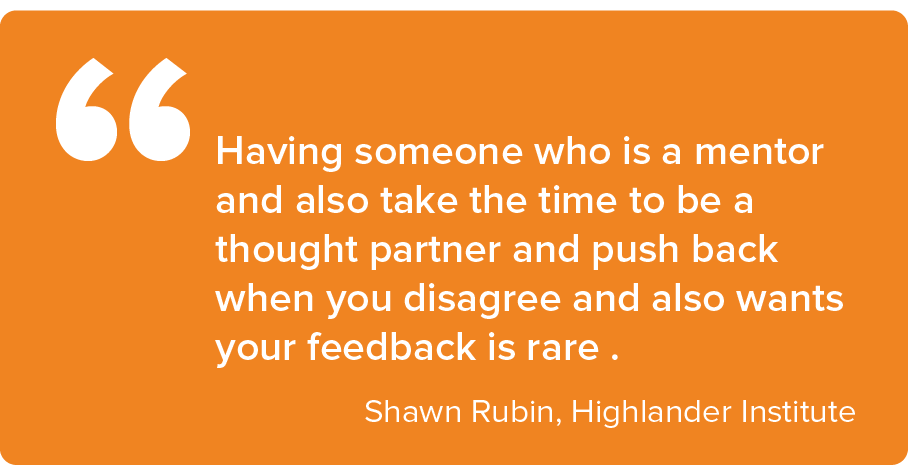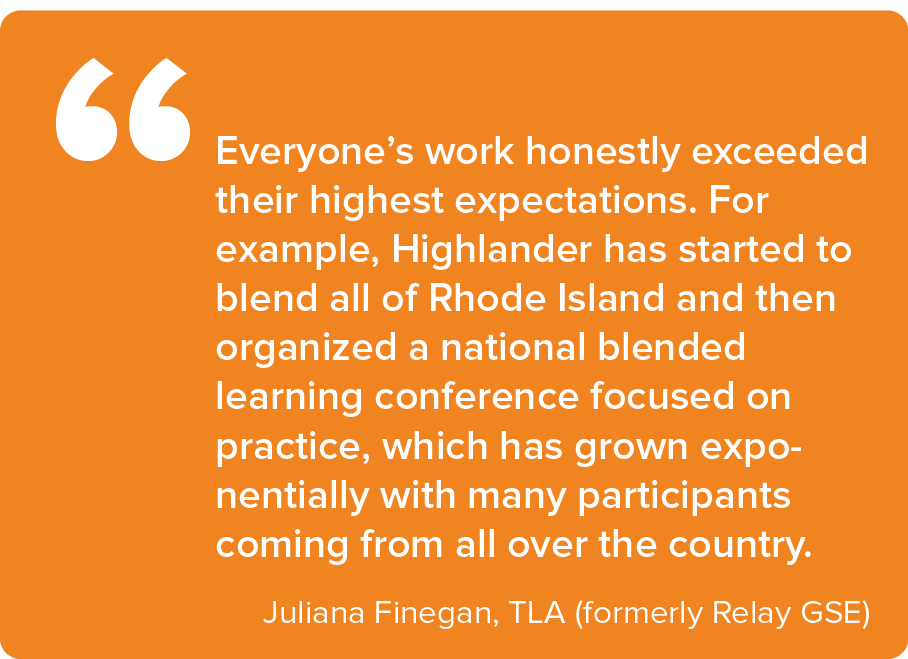School systems are inherently social enterprises: people are critical to quality and innovation. Supporting educators in moving to new approaches is critical to achieving our vision for blended and personalized learning. Given this, TLA quickly identified a problematic ecosystem gap: educators did not have a sufficient number of resources to turn to when engaging in new models. Our goal with our human capital work was to help districts build staff effectiveness - at many levels and across roles - to ensure blended learning transformation efforts would be successful.
Research and Insights
Shortly after launching TLA in 2013, we commenced our human capital work by engaging in research with Bellwether Education to better understand the needs of teachers. This research provided initial framing around the nature of the problem, both in terms of the task for practitioners as well as gaps in support nationally.
To address increasing knowledge around the nature of the challenge for educators, we partnered with iNACOL to release the first comprehensive framework to guide practitioners in understanding and identifying the critical knowledge, skills, and dispositions needed for teachers, the Blended Learning Teacher Competency Framework.
With this strong framework and our landscape analysis to guide us, we turned to the task to building ecosystem capacity for support. The following insights drove our strategy:
- There was immediate and urgent need for human capital supports,so we needed to quickly develop some effective resources in parallel with supporting excellent longer-term resources.
- Our investments should include resources for school and district leaders, as well as teachers, in order to increase the capacity of end-users at multiple levels across the system.
- We should seek to develop long-term human capital solutions that replicate the changes we’re seeking to create in our blended learning schools; flexible, highly personalized adult learning opportunities that allow practitioners to assess their competencies, set goals, identify development resources, and track their growth to mastery over time.
2013 Launch of Investment Strategy
Aligned with these insights, we created a strategy to fund a cohort of human capital organizations working across the ecosystem. We identified high-quality organizations that could create a set of open resources to help solve the human capital problem and provided active capacity support in a networked way. Similar to a venture capital strategy, we believed we would achieve maximum impact by betting on a number of initiatives, to both push for a few winners and allow the cohort to learn and iterate on their work together in a collaborative fashion.
Beth Rabbitt, our current CEO and formerly the partner who led the human capital work, acted as a critical support and advisor in developing the funded initiatives. Shawn Rubin, Chief Education Officer at the Highlander Institute, said “Beth was a thought partner in the development of our grant and in our implementation to help us answer the question of how to incentivize more district leaders to get engaged in blended learning.”
Our investment strategy funded a series of interconnected and complementary initiatives.

2014/15 Development of Resources and Transformative Impact

Over an 18-month period, our grantees worked both independently and together as a cohort to develop a compelling set of open resources to address the needs of educators transitioning to blended and personalized learning environments. One of the unique features of our funding model was to act as a resource to grantees’ projects, pushing the cohort's thinking, testing assumptions, and catalyzing stronger work. The combination of support, trust, and understanding ensured our investments were transformative for the grantee organizations. As Rubin noted, “Beth has a really good gauge of what it is real and not real in the space and has been for me, an incredible filter. Having someone who is a mentor and also take the time to be a thought partner and push back when you disagree and also wants your feedback is rare.”

Dr. Mary Ann Wolf, Director of Digital Learning Programs at the Friday Institute confirmed that “the incredible flexibility TLA provided led us to think and our great partnership allowed us to arrive at a great outcome. We never felt stuck doing something because it was part of the initial grant, we were allowed to improve along the way.”
According to Juliana Finegan, Relay’s former Director of Personalized Learning (and now TLA partner leading our next round of Human Capital work), “Relay has been at the forefront of efforts to provide teachers with practical, concrete techniques and strategies that they can use immediately in their classrooms, though much of its curriculum had been focused on teaching in traditional classroom models. Through their partnership with TLA, Relay researched and developed a suite of new, online resources to provide educators with tangible tools to personalize their instruction. Relay’s approach demonstrated one way that teacher preparation programs can adapt to meet the changing needs of today’s schools.” This was also the first time Relay had free content to share which was openly licensed and TLA helped provide the support and expertise for how to design and offer open resources. According to Finegan, “without TLA, Relay would not have had the opportunity to share their curriculum openly and/or have the resources to do as much research as they did around best practices on a national level.”
Another element of our investment strategy encouraged grantees to include research funding in their proposals, which allowed for evaluations along the way. This learning can often be lost. Wolf commented, “We don’t always stop to learn. TLA was very willing to do this and pushed us to build research into our pilot.”
For BetterLesson, TLA’s investment allowed them to get on the map in a very early moment by having credibility around blended and personalized learning. According to Jeff Liberty, BetterLesson’s Vice President for Personalized Learning, “the content in the Blended Teacher Master Project is the most consumed free content of all the master projects we have, even though the number of teachers profiled is the fewest.” The demand for good professional development resources for educators was in place and TLA’s investment allowed BetterLesson to meet the need with its set of videos and resources. TLA's investment helped BetterLesson build its internal capacity and understanding so they were able to offer strategies and a point of view about professional learning in the personalized and blended learning space through its PersonalizedPD process.” Liberty explained, “It is almost impossible to be an agent for personalization for students if you have not had this experience yourself.”
2014 Cohort Convenings Catalyze Excellence
We brought the cohort organizations together four times over course of 18 months. Organizations also convened in working groups and received regular 1:1 direct support. Many of the organizations reported tremendous impact from their work with TLA and the broader human capital cohort.

The cohort helped the organizations accelerate their learning. Instead of working in silos, they got multiple perspectives, had their thinking pushed, felt part of a community and collaborated to arrive at the best solution for the challenges they faced. We strived to facilitate connections between the group and connecting their work in order to build a pipeline of experts in this field. According to Finegan, “everyone’s work honestly exceeded their highest expectations. For example, Highlander has started to blend all of Rhode Island and then organized a national blended learning conference focused on practice, which has grown exponentially with many participants coming from all over the country."
Shawn Rubin explained, “The cohort convenings were fantastic. Beth brought together a group of super smart people that helped push my thinking, and push the Fuse program further. Beth is a excellent facilitator, which allowed for good use of time, and she pushed the group in terms of collabo- ration and thinking about systems which would work together.”
The cohort gatherings included visits to di fferent innovative schools to explore representations of what high-quality blended learning looked like. “We were very much a Rhode Island based program and hadn’t had the luxury to visit innovative schools in different parts of the country. The opportunity to see Summit and First Line, among others, helped us to rethink aspects of the Fuse program design ", said Rubin. “It was like built-in R&D for the Fuse program.”
According to several cohort grantees, the TLA team was very supportive and welcoming as we offered other supports such as outreach and communications. Liberty remarked, “The ongoing dialogue with the TLA team and cohort made everybody’s thinking better and made our products better.”
Ripple Effects Continue
As the organizations in the human capital cohort expand on their funded projects, there have been incredible ripple effects from TLA’s initial investments.
- BetterLesson launched the Master Teacher project and from its success, BetterLesson is using this work to redefine how it works as an organization in terms of how professional development is provided. It has moved to a personalized learning approach for adults, mirroring how blended and personalized learning works with students. According to Liberty, “the work we are doing in personalized professional development has its biggest focus on blended and personalized learning. Our blended pathway is the highest demand and is a huge growth driver. This all started with our TLA grant; we weren't an organization that was particularly well known for our blended learning expertise prior to the Blended Master Teacher Project.”
- Highlander Institute was able to launch its first cohort of Fuse Fellows from its TLA investment. It currently is running three different cohorts to support transformation and they have incredible demand for the program. Participating in the Fuse Fellows is quickly becoming a coveted experience for Rhode Island educators. Highlander is getting requests for Fuse programs in other locations such as Syracuse and the state of Nebraska and now receives follow-on support from The Bill and Melinda Gates and Overdeck Foundations.
- Friday Institute has expanded to 20 cohorts and its program has reached over 1000 principals. According to Wolf, “TLA and Beth had the foresight to build in a sustainability piece which pushed us and encouraged us to build training guides for facilitators and a digital platform to increase our capacity to provide training to additional sites.” North Carolina is to provide funding for three cohorts of principals this year and next year. Friday Institute is now working with 17 organizations in 14 states across the country. TLA’s partnership, investment, and forward planning has allowed Friday Institute to ramp up more quickly and with higher quality.
- Relay GSE plans to open Relay Bay, a campus which will be focused on pathways to support teachers in personalized and blended learning. By offering open resources, Relay’s modules have been used in a number of innovative and interesting contexts, such as in Raise Your Hand Texas.
Through this work, TLA’s cohort of organizations continue to create resources for educators transforming their classrooms through blended and personalized learning, thinking differently about approaches to professional development and the movement towards personalized professional development for educators to reflect what will happen for kids in personalized learning environments.
 Exponential Learning Initiative
Exponential Learning Initiative

